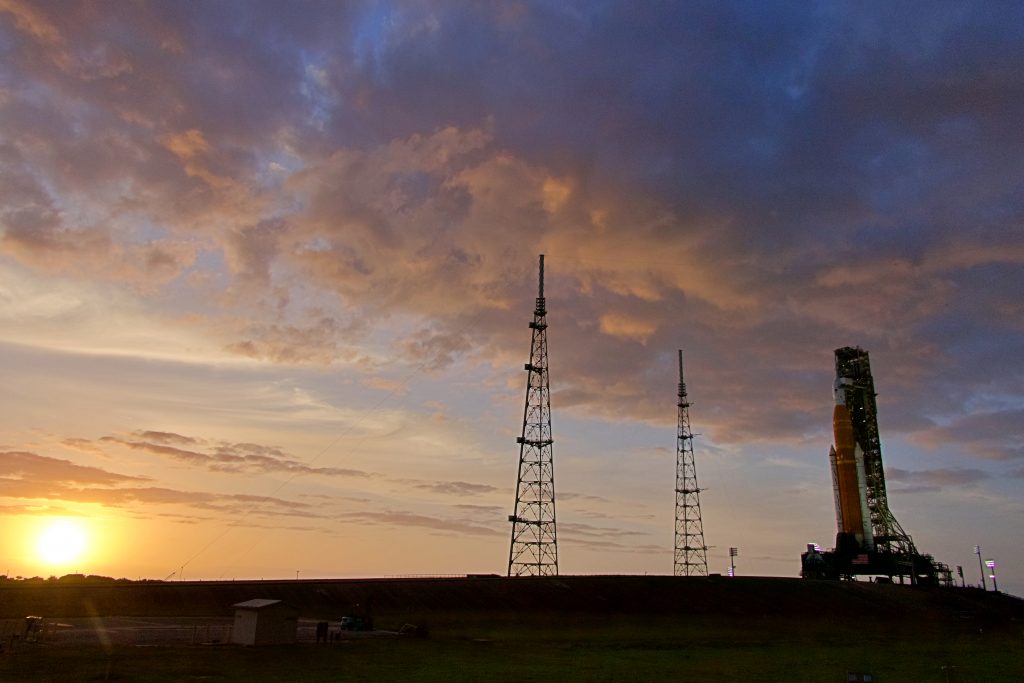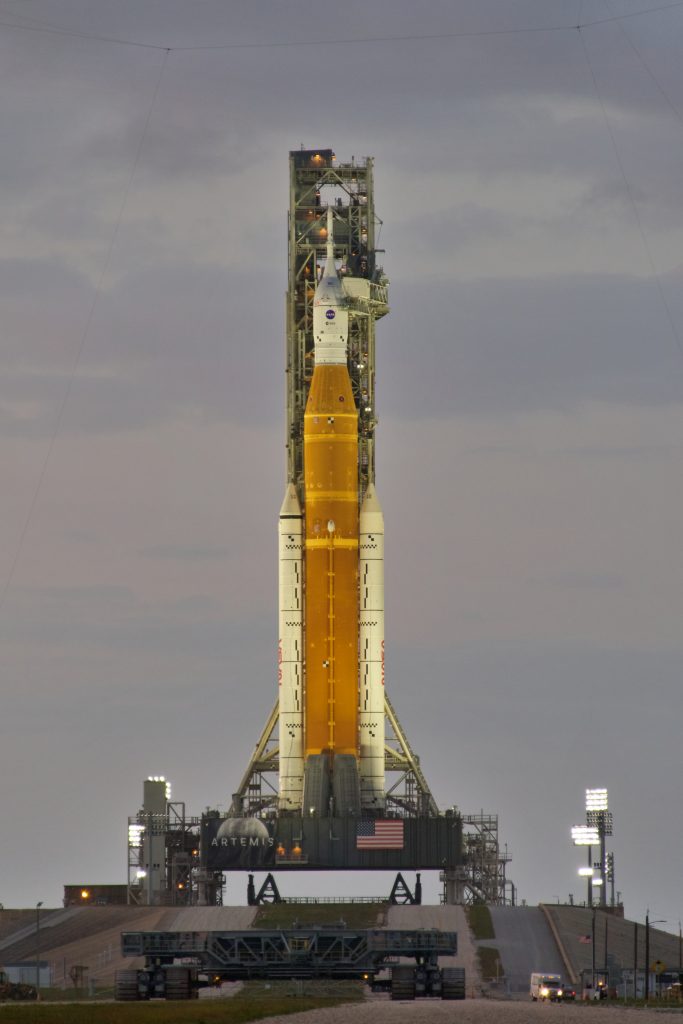When Artemis I is ready to launch, personnel from NASA, ESA, industry, and international partners will be poised to support the mission, but the rocket cannot liftoff at any time. The alignment of the Earth and Moon determines when the Space Launch System (SLS) Moon rocket with the uncrewed Orion spacecraft can launch, along with several criteria for rocket and spacecraft performance.
To achieve all the objectives of the mission, mission control needs to consider the complex orbital mechanics involved in launching on a precise trajectory toward the Moon while Earth rotates on its axis and the Moon orbiting Earth.
Generally there are two weeks of launch opportunities, followed by two weeks without launch opportunities.

Launch parameters
There are four primary parameters that dictate a launch possibility:
- The launch day must account for the Moon’s position in its lunar cycle so that the SLS rocket’s upper stage can time the trans-lunar injection burn with enough performance to successfully intercept the “on ramp” for the lunar distant retrograde orbit. The more powerful Exploration Upper Stage on future configurations of the rocket will enable daily, or near-daily, launch opportunities to the Moon, depending on the orbit desired.
- The resulting launch path for a given day must make sure Orion is not in darkness for more than 90 minutes at a time so its European solar array wings can receive and convert sunlight to electricity and the spacecraft can maintain an optimal temperature range. Mission planners discard launch dates that would send Orion into extended darkness during the flight. This constraint requires knowledge of the Earth, Moon, and Sun along the mission trajectory before the mission even starts, as well as an understanding Orion’s battery state of charge before entering an eclipse.
- The launch date must support a trajectory that allows for the skip entry technique on Orion’s return to Earth. A skip entry is a maneuver in which the spacecraft dips into the upper part of Earth’s atmosphere and use that atmosphere, along with the lift of the capsule, to simultaneously slow down and skip back out of the atmosphere, then reenter for final descent and splashdown. The technique allows engineers to pinpoint Orion’s splashdown location and on future missions will help lower the aerodynamic breaking loads astronauts inside the spacecraft will experience, and maintain the spacecraft’s structural loads within design limits.
- The launch date must take the landing date into account. Orion’s splashdown should be during daylight in the Pacific Ocean to assist recovery personnel when they locate, secure, and retrieve the spacecraft.
The launch period also influences the duration of the mission: between 26 and 28 days, or between 38 and 42 days. Orion either does a half lap or one and a half laps around the Moon in the distant retrograde orbit before returning to Earth
As the Moon and Earth continue to orbit in similar ways to the first Apollo missions to the Moon the first part of this vintage NASA video explains some the parameters well. The second part is not relevant for Orion and the European Service Module as the spacecraft is heading towards the lunar Gateway as a staging point and so future missions will target the same orbit as the Gateway. As the European Service Module relies on solar power, sunlight is also a factor that the Apollo spacecraft did not need to consider.
Current launch dates
These are the possible launch periods for 2022. Mission planners refine the periods based on updated analysis approximately two months before they begin and are subject to change.
July 26 – August 10
13 launch opportunities
No launch availability on August 1, 2, and 6
August 23 – September 6 (preliminary)
12 launch opportunities
No launch availability on August 30, 31, and Sept. 1
September 20 – October 4 (preliminary
14 launch opportunities
No launch availability on Sept. 29
October 17 – October 31 (preliminary)
11 launch opportunities
No launch availability on October 24, 25, 26, and 28
November 12 – November 27 (preliminary)
12 launch opportunities
No launch availability on November 20, 21, and 26
December 9 – December 23 (preliminary)
11 launch opportunities
No launch availability on December 10, 14, 18, and 23
A full calendar can be downloaded from NASA here.
In addition to the launch opportunities based on orbital mechanics and performance requirements, there also is an operational constraint driven by infrastructure at NASA’s Kennedy Space Center in Florida, USA. Because of their size, the sphere-shaped tanks used to store cryogenic propellant at the launch pad can only supply a limited number of launch attempts depending on the type of propellant. Liquid oxygen and liquid hydrogen are loaded in the rocket’s core stage and upper stage on the day of launch. Should the launch subsequently be called off, there is a minimum of 48 hours until a second launch attempt can be made. There is then a 72-hour minimum before a third attempt can be made, due to the need to resupply the cryogenic storage sphere with more propellant. In any given week, no more than three launch attempts that include core stage tanking can occur.


 Automated Transfer Vehicle page
Automated Transfer Vehicle page ATV blog archive
ATV blog archive
Discussion: 5 comments
Man, even reading this simplified version of the process of space launches makes me wish I knew more about Orbital mechanics
If you haven’t tried it yet, Kerbal Space Program (game/simulator) is a great way to learn about orbital mechanics.
You wrote ‘A full calendar can be downloaded from NASA here.’
But You didn not converted the word into a link (I am currently using a Smartphone with Google Chrome, maybe that is why I cannot see it).
Thank you very much for posting this article.
That’s weird because I distinctly remember posting the link twice. Three times lucky, and if not it is here: https://www.nasa.gov/sites/default/files/atoms/files/artemis_i_mission_availability_aug2022.pdf
Great article, thanks so much!